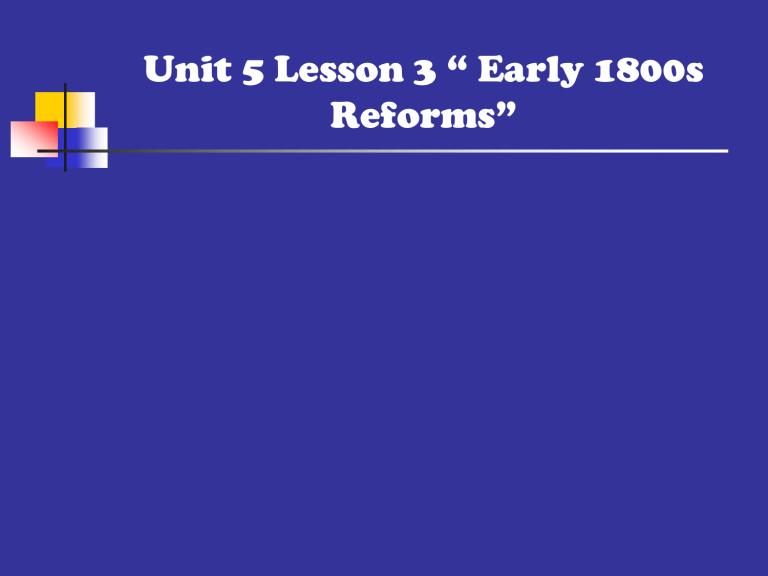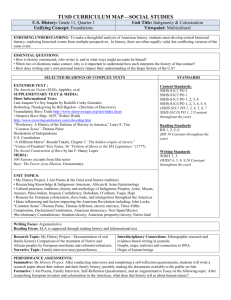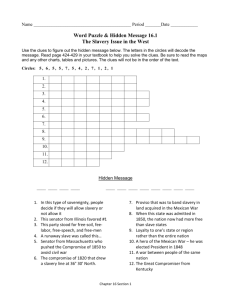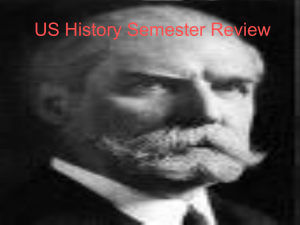AmHistUnit 5 Notes

Unit 5 Lesson 3 “ Early 1800s
Reforms”
Societal Change
2 nd Great Awakening was a period of religious revival after 1800
Charles Finney and others held tent meetings or camp meetings
Utopian Communities were communal societies based on everyone working together and sharing the output.
Most did not work well
New Harmony
Oneida
-Shakers
Transcendentalism
Was a belief in a simple lifestyle , back to nature.
-Walt Whitman
” Leaves of Grass ”
-
Ralph Waldo Emerson
” Self-Reliance ”
-
Henry David Thoreau
” Civil Disobedience ” -don ’ t obey immoral laws.
Education
-Was mostly done in one room schools
-Few were educated beyond age 10
Horace Mannadvocated for public schools for everyone
Noah Webster developed an
American dictionary , standardized spellings.
Institution Reform
Dorothea Dix
- help for the mentally ill
-helped to start several mental hospitals
-
prison reform
-meant to rehabilita te, not just punish! (Correctional facilities)
American Writers
James Fenimore Cooper
“ Last of the Mohicans ” adventure novels in the
American west
Nathaniel Hawthorne
“ Scarlet Letter ” - A for adultery
Washington Irving
“ Sleepy Hollow ” - headless horseman!
Herman Melville
“ Moby Dick ” Captain Ahab v the White Whale!
American Writers
Edgar Allan Poe
“ The Raven ” and other poems and short stories.
Emily Dickinsonreclusive poet
Hudson River School
-landscape painters
-Alex de Tocqueville
“ Democracy in America ” – the French writer ’ s observations on the US democracy & people
Life under Slavery
-Rural Slavery
-worked on plantations
- could do field work which was very hard.
house workers usually had easier lives, but it could come with a price.
-Urban slavery fairly rare.
skilled labor
-more freedoms
Abolitionists
Abolitionists opposed slavery
William Lloyd Garrison was editor of “ The Liberator ” an abolitionist newspaper.
-David Walker wanted to gain freedom by force.
Frederick Douglas former slave, speaker, editor of “ North Star ”
Rebellion
-Slaves turn to violent methods, instead of just passive resistance
Nat Turner , 1831 led a deadly slave revolt which scared many slave holders in the south.
-This revolt led to greater control over slaves- including black codes , which restricted slaves even more!
Anti-slavery
-Some wanted gradual emancipation with compensation to owners, while others wanted it immediately
-Many who were abolitionists were so for religious reasons and that it was morally wrong to have slaves
Many said slavery was in conflict with the values of the Declaration of
Independence & Constitution
Pro-slavery
-New fear of revolts led many to oppose abolitionism as a threat to public safety .
Black codes are passed to restrict slaves (eg, banned from learning to read & write.)
-Some people gave religious support to slavery.
- A ” happy plantation slave” myth was created to excuse slavery.
Women in Society
Cult of domesticity said women should care for husband, children, home, church.
-Women could not vote in virtually any place.
In most states women could not own property or keep wages if husband was alive.
Reformers
Abolitionists wanted to end slavery.
Suffrage expanded rights to vote
Grimke sisters -abolitionists & women ’ s rights from SC.
Lucretia Mott, Elizabeth
Stanton, Susan B. Anthony,
& Sojourner Truth
Temperance - was a movement to ban alcohol because of its social ills.
Women ’ s Movement
Women saw increased opportunities in reform movements
-At the Seneca Falls
Convention , in 1848 a “ Declaration of
Sentiments ” was written to demand rights for women .
Reforms
-Women ’ s Education
Catherine Beecher - home economics for girls
Oberlin College -women ’ s college
-Health Reform
Elizabeth Blackwell - first
US woman to receive a medical doctorate.
Amelia Bloomer - reformer for women’s rights and temperance.
Markets Expand
-By the mid 1800 ’ s people were no longer totally selfsufficient, they would produce one product, buy all others
-Factories created more specialization
-Capitalism increases productivity.
Standards of living rose for almost everyone.
Transportation Changes
Robert Fulton invented steam powered ships
-Many canals were built after the Erie
Canal was completed and profitable
-The growth of railroads continued to increase.
Inventions Improve Life
Charles Goodyear vulcanized rubber, a tougher form.
I.M. Singer -sewing machines
Samuel Morse invented telegraph
& Morse code
Agriculture
-People began to move into the midwestern parts of the nation where lots of available farm lands
John Deere invented steel plows which made it easier to till the plains.
Cyrus McCormick invented the mechanical reaper which meant more crops could be harvested.
Changing Workplace
The development of industry led to increased production which decreased the cost of goods while increasing the supply .
-Factories led to a decline of skilled labor, as they were replaced by machines.
-Industrialization also led to urbanization , or the growth of cities.
-Remember the Lowell
System?
Working Conditions
-Had to work long hours 12-
14!
-Had to work six days a week.
-Factories offered poor ventilation and lighting
-People endured unsafe working conditions
-These conditions led to the development of labor unions and strikes
Immigration
-US had lots of immigration in the mid 1800’s
-Most immigrants were Irish or German
-Most immigrants settled together in groups at first in the cities.
Low wages of immigrants caused problems with other workers.
-Growth of Nativism - a distrust of immigrants,
Know-Nothing, or American,
Party - didn ’ t like immigrants or Catholics




